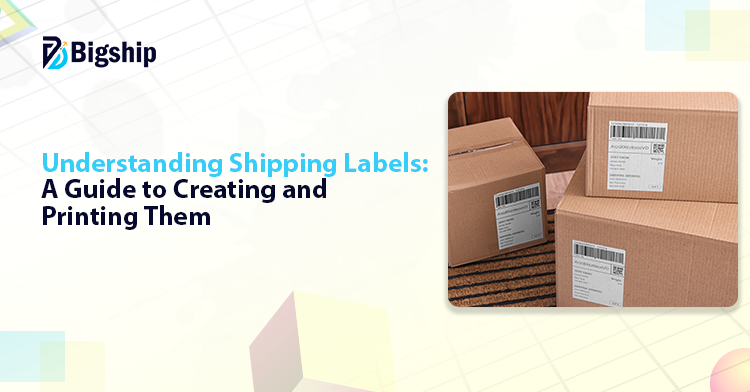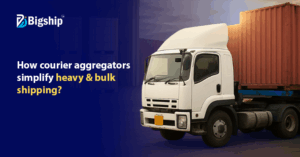Shipping labels are the essentials, that ensure the smooth functioning of the logistics and transportation industry. The labels contain vital information that prevents the goods from reaching their intended destinations.
A shipping label acts as the credential for items in the supply chain, providing all information, including the recipient’s name, description of goods, quantity, value of goods, origin of shipping, and destination address. This complete information eases logistics operations, thereby reducing delays, costs, and manual efforts. Currently, companies use shipping labels to fast-track the dispatch of parcels, enhance customer experience, and build brand trust and loyalty.

Now that we understand the importance of an efficient shipping label, we bring you all the shipping label information. Let’s get started.
What is a shipping label?
A shipping label is a very important identification used in logistics and provides information about the contents of the package. Labels on parcels, cartons, or containers describe what is inside, giving information for its handling and transportation.
They may include important notes regarding inspections required as part of the supply chain management process.
The shipping labels will feature the address of both the sender and receiver, hence making them crucial for the monitoring and tracking of orders placed on e-commerce platforms.
By incorporating shipping labels, businesses can significantly reduce the large margin of delivery errors. Accurate labeling is crucial for avoiding costly mistakes, preventing delays, and ensuring timely deliveries.
How do shipping labels work?
Shipping labels contain essential information regarding the origin and destination of the package so that the shipment is valid at every stage and can be traced during the entire delivery procedure.
Each courier uses a specific format of labels that is easy to read and compatible with the courier systems, which is readable by humans and machines for smooth operations.
A standard shipping label includes:
- Sender’s name and address
- Recipient’s name and address
- Tracking barcode
- Routing code (for internal sorting path)
- Maxi code (scannable for fast processing)
- Tracking number (for order tracking)
- Destination postal code
- Service level (e.g., express or standard)
- Package weight and size
- Quantity of items
- Order number
- Shipping date
- Item description (mainly for international shipping)
- Courier/carrier details
8 Key Benefits of Shipping Labels
Here’s how shipping labels can enhance your operations and boost efficiency:
- Easy Identification & Tracking: Shipping labels function as package ID numbers. They allow both the logistics provider and customers to track the shipment through information such as the sender or receiver, the origin, the destination, and the tracking number.
- Cost-Effective: Shipping labels help cut shipping costs by removing the need for manual labeling, reducing errors and labor expenses. They also speed up the delivery process. Plus, by using label templates, you can skip extra tape, thus, solving both packaging and tracking with one simple solution.
- Regulatory Compliance: Labels follow the legal requirements for shipments so that the goods are shipped safely and legally.
- Accurate & Automated Information: The barcodes and the codes on the shipping labels are easy to scan from a very easy point of view, thereby reducing manual entry during the identification of goods.
- Better Customer Experience: Labeling projects a brand image, which in turn establishes credibility. Eco-friendly labels or durable ones build trust among customers, further solidifying loyalty.
- Efficient Delivery Management: Shipping labels help logistics companies track products in the warehouse and speed up deliveries. They also allow you to manage and prioritize orders based on your customer needs.
- Flexible Customization: Creating high-quality, seasonal, and customized shipping labels boosts the customer experience. Labels can be customized with product-specific or customer-specific information, seasonal themes, or branded designs.
- Simplified Returns: With shipping labels, you can create a return label template, email it to customers, and ask them to print and attach it to their return package. This makes the return process very simple and convenient for customers.
Format and Template of Shipping Labels
Businesses like UPS, FedEx, and Amazon have shipping label designs exactly tailored to customers’ requirements. The labels are generated through a web application to help internal logistics, while order tracking helps customers via company websites or apps.
The shipping label allows for tracking and confirmation of the order’s delivery process, for example, on an expected date of delivery and time slot. It also shows necessary information such as the sender’s and recipient’s addresses, tracking ID, and service type.
These labels are specially designed and printed in the dispatch center for each parcel. These labels are company-specific and, therefore, not changeable. They have to be fixed at every point in the supply chain to maintain good traceability of the delivery process.
Without a label, it would be nearly impossible to trace lost, damaged, or delayed shipments because from then on, the company loses the visibility of where in the logistics process the problem occurs.
Labels differ concerning their size, format, and outlook, and are individually customized for each order, so the tracking is done with the highest degree of accuracy. In most cases, businesses print test labels for a quality check before mass printing.
Shipping Label Best Guidelines
Shipping labels are “very important” tags required when delivering a package. They contain all the needed information and are retained on the package until it reaches the customer. Here are five essential tips to ensure problems don’t crop up during shipment:
1. Know What You’re Shipping: Before printing a shipping label, know exactly what you will be sending. To cite a few, special handling needs to be accorded to items like glassware, groceries, or pharmaceuticals. Hazardous items, such as perfumes or hand sanitizers, must comply with safety policies with clear specifications to that effect on the label to ensure proper handling of the package and its safe delivery.
2. Cross-Check Shipping Information: It is important to have all the information on the shipping label correct. One small error in the zip code or a missing apartment number will send the package to the wrong place, or worse, create a delay. Wrong information might also cause invoices to be incorrect or stock to be misplaced.
3. Preparing the Budget for Shipping: When selling online, staying solvent for shipping expenses must be your priority. Shipping costs can be hefty for heavy and international parcels. They are calculated based on weight, dimension, and distance.
4. Insert the Packing Slip Inside the Package: A packing slip is a very important document in the shipment, and maybe the seller would not even face a refund request if it is properly prepared. This is a waybill printed inside the package, detailing the contents of the box, who ordered it, your address, and the date of purchase. Some may also know from this sheet their return or refund policy, who will pay for return shipping, etc.
5. Work with the Right Shipping Partner: A great shipping partner will take half the headaches from your shipments. Look for one that can get your packages over a wide delivery range, has good customer support, and has great real-time tracking. And these shipping platforms often allow for side-to-side comparison of rates and features, so find the one that fits your budget and needs. A good partner, like Bigship, will enable faster shipment, printing of labels, to automation, and keep customers posted.
Where to Put Shipping Labels on the Box?
The shipping label must be placed on the largest flat side of the package, often on the top surface. This location helps to protect the label from falling away and reaching nowhere near the intended customer.
Make sure the label fits perfectly in the area assigned for it on the box surface. Do not allow any part of the label to go beyond the edges of the surface because the relevant information may be obscured, hence making it difficult to read or scan. The label must be fixed properly with good adhesive, lest it float free or get damaged. It must stay in place and be visible enough to be read through the whole delivery.
For international shipments, a clear tape can be used to cover the label, or it can be put into a plastic sleeve to safeguard it against water damage and the label from tearing.
If you have any specially treated items like fragile, perishable, hazardous, or flammable things, inform your delivery carriers, and put an extra notice on the package, thus preventing damage, creating negative customer reviews, or reshipping.
How to print shipping labels for delivery?
Nowadays, shipping labels are mostly generated automatically by shipping companies, which is kind of helpful for sellers because they don’t have to worry about label design and formatting.
If you use a shipping company’s label-making tool, you often have to send tracking and delivery information to your customer yourself, usually by email. This enables the customer to track their order and know when it will arrive.
When you create shipping labels on an online selling platform, the steps become much easier. This is because such platforms already have the email and order details of the customer. So, they can automatically show the tracking number on the customer’s account. The customer can then log in to track their order or get updates through email.
If you’re using special shipping software, there’s one extra step. Once an order is packed and ready, the software sends the tracking details back to the selling platform. This keeps everything in sync, so customers get updates without delay.
Ship with confidence using Bigship’s services
Every shipping label generated through Bigship includes key details like origin, destination, and product info via barcodes or QR codes. These labels enable smooth tracking and faster deliveries.
Bigship, through its built-in tracking and delivery confirmation, ensures your package is traceable at every step, right from pickup to final delivery.
Conclusion
Keeping your deliveries on time while giving information to customers at every step requires tracking and logistics operations to be monitored. Bigship simplifies this process through an integrated dashboard that provides real-time order status, tracking ID, and delivery confirmation updates like everything in one place. With the right services, experienced logistics support, and streamlined operations, Bigship assists in elevating your customer satisfaction while simplifying your shipping process. You can enter your Order ID or AWB number on Bigship to track your order easily.
Sign up to Bigship shipping account now to enjoy a hassle-free shipping management.





